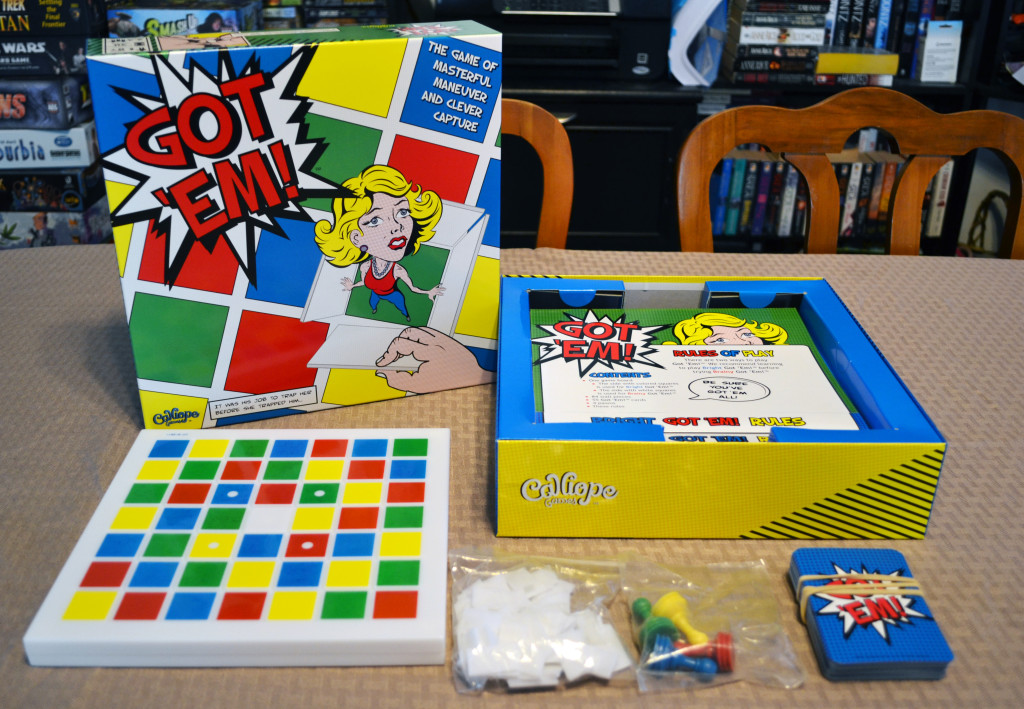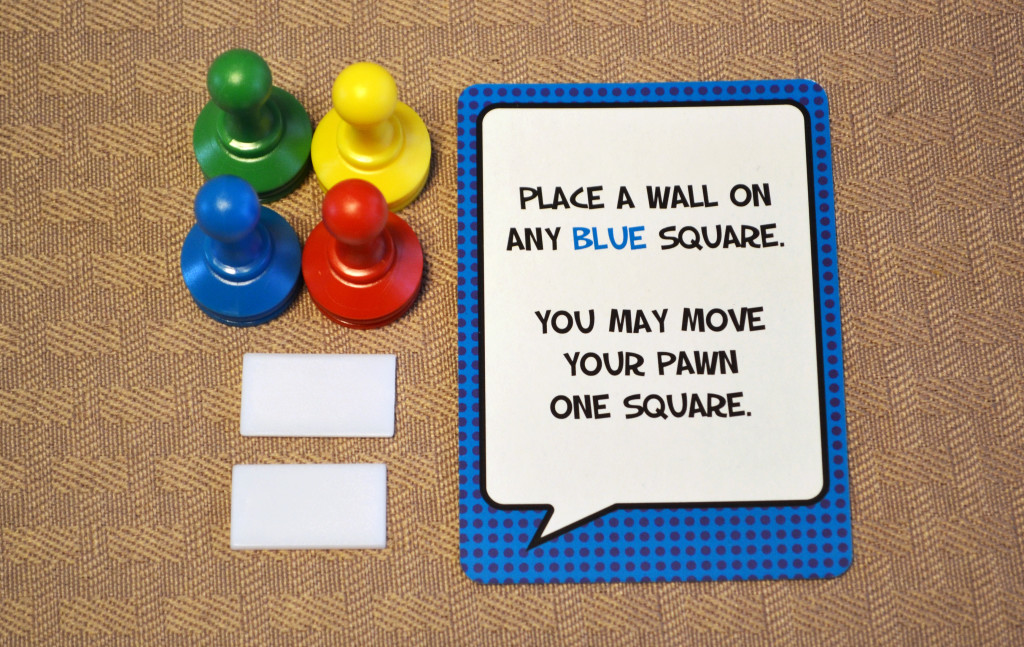Elimination games can be hard to play with others sometimes, depending on the group. Those who hate losing or always feel like they’re being ganged up on can ruin the entire experience for everyone else. “Tsuro” is one of those rare games that my household will play on a regular basis, despite the fact that winning involves being the last one on the board. I think it has to do with the fact that you’re limited to placing tiles adjacent to your own pawn…if others happen to be affected by it, all the better. There’s a little of that in “Got ‘Em” as well, though it does tend to be a bit more aggressive. Before we take a brief look at what this game has to offer, I’d like to thank both Ray Wehrs and Cassidy Werner from Calliope Games for providing me with a free press copy. If the names sound familiar, it’s because Calliope Games are the same folks who created “Tsuro“, “Tsuro of the Seas“, and “Roll For It!“.
Components
Board – The playing board is double-sided. The side you choose will determine which of the two game variants you’ll be playing. One side contains blank squares (called the brainy side) while the other contains colored squares (called the bright side).
Wall Pieces – These are what players will be using to attempt to trap other players.
Pawns – There are four player pawns, one for each player in the game.
Cards – Cards are used for the bright side only and are discarded when utilizing the brainy side. They contain instructions on how to move a player pawn and place walls.
Setup & Gameplay
As noted above, there are actually two ways to play. The goal of both rule sets are the same: surround your opponents’ pawns on all sides with walls to entrap and eliminate them from the game. To set up the game, players will choose a side of the board and then a player pawn to call their own. If players utilize the bright side, they’ll shuffle the cards and deal three to each player face down. In the brainy rule set, they are simply placed back into the box. The person who has a birthday closest to today’s date goes first.
Bright:
A player’s turn while playing the bright side consists of the following:
1. Play a card – The current player will play a card face up and follow the instructions on said card.
2. Place a wall – Placing a wall comes first, followed up by the movement of that player’s pawn. The current player must place the wall next to the colored square indicated on the card. If this should result in a player being surrounded on all sides, they are eliminated and their pawn is removed from play. As a reward for eliminating another player, the current player may remove one wall from the board.
3. Move your pawn – Once the wall has been placed, the current player MAY move up to the number of spaces listed on the card. A pawn doesn’t have to move at all, if the player so desires. Pawns can’t move through walls or other players, nor can they move diagonally.
4. Draw a card/End turn – The current player will end their turn by drawing back up to three cards. Play proceeds clockwise.
The last player to have a pawn on the board, wins the game!
Brainy:
A player’s turn while playing the brainy side consists of the following:
1. Place a wall – Placing a wall comes first, followed up by the movement of that player’s pawn. The current player must place one wall anywhere on the board. If this should result in a player being surrounded on all sides, they are eliminated and their pawn is removed from play. As a reward for eliminating another player, the current player may remove one wall from the board.
2. Move your pawn – Once the wall has been placed, the current player MAY move up to the number of spaces equal to the number of walls next to them. If their pawn is touching two walls, for example, they can move UP to two spaces. A pawn doesn’t have to move at all, if the player so desires. Pawns can’t move through walls or other players, nor can they move diagonally.
3. End the turn – Play proceeds clockwise.
The last player to have a pawn on the board, wins the game!
—
The above doesn’t cover all of the rules found in the manual, but should give you an idea as to how the game is played. For more information, you can check out the manual here:
The Review
In terms of difficulty, the game is very easy to play. In fact, I didn’t need to explain the directions more than once to Vinnie Jr (13). The PDF directions I downloaded from the official site (link above) is only a page long, making it the kind of game that grandparents can play with their grandkids without having to feel overwhelmed by complex rules. I can’t speak for everyone my age, but the older I seem to get, the less complicated I like my games to be. Perhaps it has something to do with having a full-time job and consistent “dad” duties? At any rate, the components themselves were very colorful and the cards easy to read. Overall, I was very pleased with everything that came out of the box.
I like the fact that there are two different ways to play, as one is more strategic than the other. The bright rule set is a bit more luck-based, as the walls you place are dependent on the cards currently in your hand. Let’s say for example that your opponent is sitting on a square surrounded by three walls. The last wall you need to place in order to win the game has a groove that borders a red and blue space. If you have all green and yellow cards in your hand, you’ll be unable to follow through with the win even though strategically you had them in your sights. The cards for the bright side also include a few ways to get out of tight spots (the ability to move through walls, etc.), adding to the randomness that is that particular game mode. With the brainy rule set, you won’t have this problem. If you mess up and put yourself into a bad position, it’s your own darned fault.
In all honesty both game modes have merit, depending on what kind of game you want to play and what group of people you’re currently with. If your group is a casual lot who enjoy luck-based game and want a more guided experience, then the bright side will work fine. If your group favors strategy games however, you may have a better time messing around with the brainy side. As such, “Got ‘Em” would appeal to quite a wide audience. Whether you’re playing for fun or want to stretch your critical thinking muscles a bit, “Got ‘Em” has everything you’ll need. What’s more, most games only last about twenty minutes, making it ideal for families with a busy schedule. I would have liked some more ways to play strategically, but the game as it stands offers enough to scratch that gaming itch.
The price on the official site ($28.00 as of 7/2/14) is a bit high in my opinion, though Amazon has a number of offers ranging from $10.00 to $25.00. If it were me, I’d place this game somewhere in the $15.00-$20.00 range. Speaking of which, Calliope Games have provided me with a coupon code that can be used to give yourself a 20% discount should you purchase the game through their official website. That code is: GAMEADDICT. Simply follow the link below, add the game to your cart, and enter the code during checkout. The coupon will be valid from July 10, 2014 thru August 14, 2014.
Final Verdict: 8/10
—
You can learn more about and purchase “Got ‘Em” by visiting the following websites:
—




